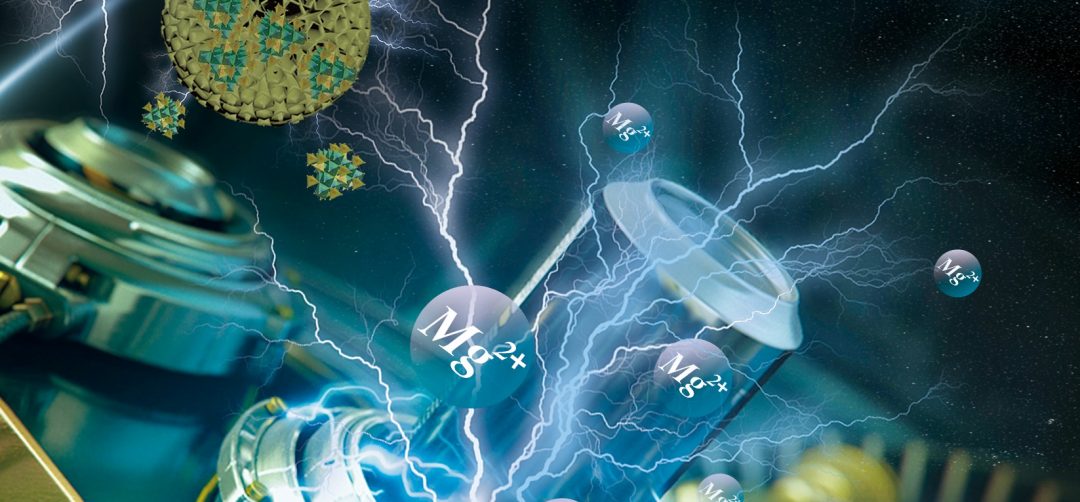It’s been a while since I rounded up the latest in battery research from across the Advanced journal family; having recently attended the ABAA-12 conference on battery technologies, it seems like just the right time to explore the state of the art. Despite its obvious advantage in terms of theoretical specific capacity (YouTube viewing hours per charge, in end user terms), safety and sustainability concerns over the future sourcing and use of lithium mean that alternative systems are under equally serious investigation.
As my article title suggests, magnesium is one such alternative that presents itself as cheaper and more abundant than lithium, and environmentally friendly – and one that is currently trending if the following recent research is anything to go by.
Layered cathode materials are a popular choice across many battery systems, and one team at Nanjing University in China has developed nanoflowers of vanadium disulfide (VS2) as a possible layered cathode for use in rechargeable magnesium batteries. The interlayer distance of their final cathode material was almost 10 Ångstroms, nearly double the spacing in the control sample (5.73 Ångstroms). This expansion was achieved by choosing a solvent, 2-ethylhexylamine, that could also act as an intercalation agent during the synthesis process. The resulting expanded lattice allowed the diffusion of magnesium ions at a rate of 10−11–10−12 cm2 s-1, with the full battery system achieving a reversible discharge capacity of 245 mAh g−1 at 100 mA g−1.
After an extensive exploration of the magnesium storage mechanism, checking on recent claims that such materials use MgCl+ rather than Mg2+ ions as the active species, the research team found evidence that, at least for their system, “both MgCl+ and desolvated Mg2+ ions may simultaneously participate [in] the cation insertion/extraction processes of [the] expanded VS2 electrode”.
This work shows how understanding the influence of structure can lead to improvements toward the next generation of battery types. To facilitate such endeavors, scientists at the University of Science and Technology Liaoning and Northeastern University, China, have reviewed what we know about the microstructure of cathodes. While they indicate that new electrolyte formulations are needed to help extract magnesium ions from the anodes, they identify the most important challenge to commercial application as being the lack of cathode materials able to manage the operating conditions of strong polarization, high charge density, and the slow diffusion of Mg2+ ions. They divide their discussion of cathode materials into the different possible structures: layered, spinel, olivine, accumulation, NASICON, open framework, as well as exploring organic and other miscellaneous materials. Most studies so far, they report, have focused on the internal structure of the cathode in order to improve the intercalation of magnesium ions; more studies of the insertion/extraction mechanisms are called for to support this work.
The authors of the review also identify five key areas for future research: increasing the occupied sites on the cathode surface; forming conductive networks from dispersed particles to improve the electronic properties of the materials; reducing Mg2+ solvation; optimizing synthesis conditions to achieve larger specific surface areas; increasing material conductivity through strategies such as coating or doping.
Taking their advice are researchers from Tokyo Metropolitan University and the National Institute for Materials Science, Japan, who assemble high-surface-area spinel MgIn2S4 microflowers from 2D nanosheets for use in magnesium batteries operated at elevated temperatures. Higher temperatures have the advantage of increasing the speed of magnesium ion diffusion kinetics, though typical organic electrolytes needed to be swapped for, in this case, a less volatile (nonflammable) ionic liquid electrolyte. The stability of the cathode was found to be acceptable between 50 and 150 degrees, achieving a capacity of about 500 mAh g−1 under 1.2 V vs. Mg/Mg2+. The Mg2+ storage mechanism was determined to be based on a three-step reduction reaction of indium, verified through CV and TEM measurements as well as X-ray techniques. When cycled at 100 mA g−1, no degradation in performance was observed for the first 450 cycles.
Rechargeable batteries based on zinc, calcium and aluminum, as well as our hero magnesium, were targeted by the authors of the last review I read, which focuses on the development of sustainable organic electrode materials for use in such metal-ion or multivalent battery systems. Working at Nanyang Technological University, Singapore, they highlight the importance of finding new redox chemistries (such as the one discovered for the spinel MgIn2S4 microflowers) to drive better battery performance: “the charge storage of electrode materials can be improved by either the reduction of molecular weight or the adoption of multiredox mechanisms”, they write, adding that some lessons learned recently for lithium battery systems could also be applied here.
For magnesium-based batteries specifically, they agree that progress is impeded by sluggish kinetics and a lack of detailed knowledge about insertion/extraction mechanisms for the different available systems. They highlight the consistently poor performance of organosulfurs as organic cathodes, labeling this as the reason research on this family of materials has stagnated, and point instead to the more promising redox-active conductive polymers or radical polymers, recommending that polymer-based cathodes should be the focus of future developments. For radical polymers in particular, they warn that new electrolyte systems will be needed to improve compatibility and avoid dissolution issues.
It’s time for me to stop, but the research into new battery types keeps on going. For more on batteries and other energy-storage technologies, check out the ongoing Excellence in Energy series – invited-only reviews from top energy researchers, free to read for a limited time.

















